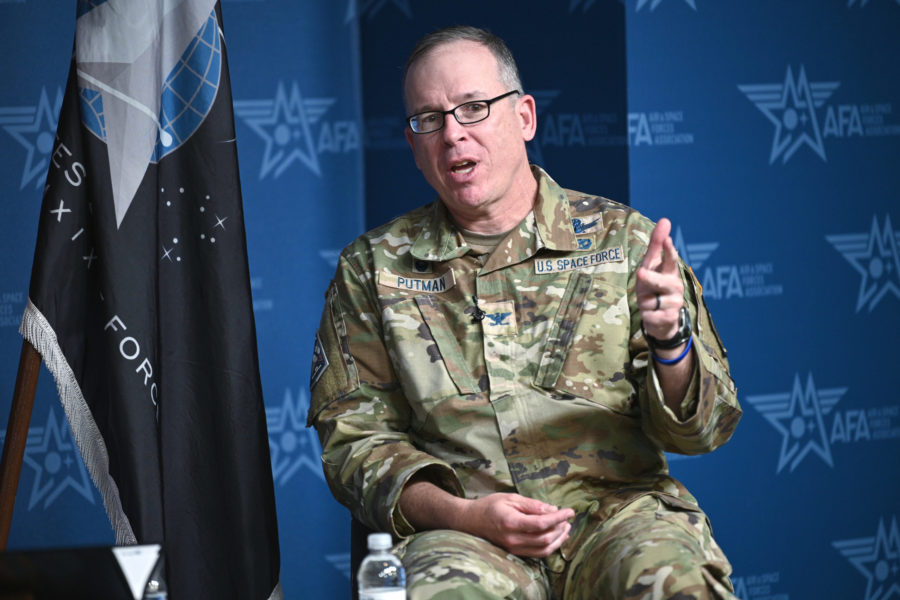The Space Force’s top commander for the Middle East faces a two-fold resource problem, he said March 27. But with the support of U.S. Central Command and the Space Force, Col. Christopher Putman hopes to grow his team to confront the myriad challenges facing the U.S. in the region.
“As we stand up a new organization and do all the things it takes to create a new organization, we can’t drop the ball on the current fight 24/7,” Putman, the head of U.S. Space Forces Central (SPACECENT), said at an AFA Warfighters in Action event. “It’s daunting, but it’s achievable.”
U.S. Central Command (CENTCOM) is not the Department of Defense’s primary strategic focus. Still, it may be one of the toughest regions for commanders, who face the challenges of fighting ISIS, confronting the persistent threat of Iran, and being prepared for potential run-ins with Russia—all with limited resources.
In addition to Central Command’s finite resources, SPACECENT faces the manpower challenges of the Space Force as well, with fewer than 10,000 Guardians. Putman’s team at CENTCOM’s headquarters at MacDill Air Force Base in Tampa, Fla. is just three people, including him. When something happens in the region that requires his response, he is just a phone call or meeting away from Gen. Michael “Erik” Kurilla, the CENTCOM commander. However, Putman has limited depth—around 30 Guardians who are mostly deployed to CENTCOM’s forward headquarters at Al Udeid Air Base, Qatar.
“It’s definitely a challenge with how few people we actually have in the space organization because after me, you’ve got my deputy, and then it starts getting real thin and it drops off precipitously,” Putman said.
Putman expects his team in Tampa to grow to around 10 Guardians as the overall SPACECENT organization expands. The command also relies on Air Force resources.
“There’s just not enough to go around and we’re working on that and we’re continuing to get bigger,” he said. “I think we are definitely getting the support of the Space Force.”
As Putman advocates for SPACECENT inside the Space Force, he also must articulate what he can provide to CENTCOM. That requires some effort: Putman’s service is relatively new, and due to the Space Force’s small size he holds a lower rank than his counterparts in other services. The Space Force has a dearth of generals, and the only Space Force geographic component command to have a general officer is in the Indo-Pacific, the DOD’s primary focus. However, Putnam said Kurilla and fellow service component commanders have accepted him in his four months in the seat since SPACECENT was activated Dec. 2.
“Despite the rank, despite the size, CENTCOM has been great,” Putman said. “We have been fully embraced as an equal partner.”
Putman had a similar job as Air Forces Central’s director of space forces before standing up the new Space Force command. But he is trying to make SPACECENT more than a rebrand of his old outfit.
“It’s a little bit of a different angle than before,” Putman said. “We had a lot of buffer between us and the combatant commander and checks and balances. But now it’s a very direct line between my very small organization straight back to the commander, providing him options. Same thing on the service side. As a component, we’ve got a direct line right back to the [Chief of Space Operations].”
Kurilla has championed innovation and autonomous solutions in CENTCOM to fill gaps that may have previously required more resource-intensive assets—whether surveilling the sea or the air through the Navy’s Task Force 59 and the Air Force’s Task Force 99, as well as a new Army Task Force 39.
The Space Force component is itself novel and small in CENTCOM. While Putman hopes to collaborate with the task forces, his command is not remotely big enough to experiment with its own dedicated unit. Instead, SPACECENT itself hopes to invent a new way of doing business through day-to-day operations.
“The fact that we have space capabilities resident in theater that belong to the CENTCOM gives us quite a bit of flexibility to create innovative [tactics, techniques, and procedures],” Putman said. “We’re learning and we’re going forward.”

